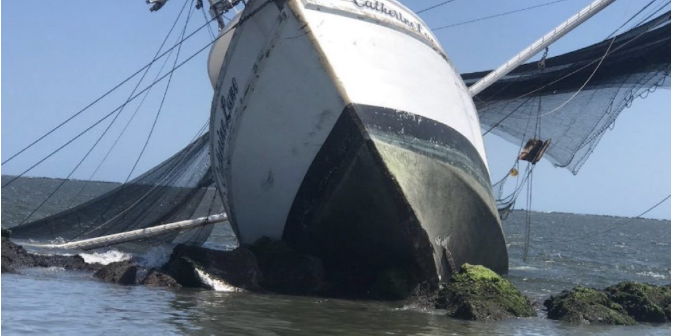The captain of a fishing boat set the autopilot as it was heading out of the St. Marys River Channel south of Cumberland Island, Georgia, last June, and then went below to talk on his cell phone, leaving the helm unattended. A few minutes later, the 78-foot boat ran into the channel’s north jetty and subsequently sank, leaking more than 2,000 gallons of fuel and oil into the water.
The National Transportation Safety Board just issued its report about the accident, concluding that “leaving the wheelhouse unattended is imprudent, especially when navigating areas like the St. Marys entrance, which included a narrow navigation channel, two jetties, and vessel traffic.” The report said if the captain had stayed in the wheelhouse he would have been able to respond when the autopilot failed.
The boat was the wooden-hulled Sage Catherine Lane, built in 1966. It had a single engine, a 600-hp Cummins diesel.
On June 9 last year, it left its anchorage in Cumberland Sound and started to head offshore for a day of shrimping. The captain had 30 years of experience on fishing boats, and there were two crew. One went to the bow to secure the anchor, and other went to his room.
The weather was clear with 10 miles visibility; the wind only 5 knots. The St. Marys Channel is 500 feet wide and 14 feet deep.
At about 9 in the morning, the captain maneuvered the boat outside the navigation channel and continued between the red buoys and the northern jetty because of a lot of boat traffic. The NTSB report said he set the autopilot to continue that course offshore.
He then answered a phone call and went to his room. A few minutes later he was still talking on his cell phone when he felt the boat turn sharply to port. The captain rushed back to the wheelhouse, trying to regain control of the boat, but it hit the jetty.
As the boat started to flood with water, the crew put on life jackets and jumped overboard. They were rescued by a passing Good Samaritan boat. One crewman suffered slight injuries.
Three days later, after a thunderstorm, the boat sank, a $1 million total loss.
The NTSB report said that two days earlier the autopilot had failed as the boat was coming into St. Augustine. The captain found problems with the rudder angle indicator and the rudder angle sensor, and he thought he had repaired them. The report said they had worked initially, but later failed as the boat was in the St. Marys Channel.
“Autopilot use does not relieve the operator of responsibility to conduct a proper navigation watch,” the report said. “Navigating in channels and harbors requires quicker reaction times due to traffic, current encountered and frequent course changes…Therefore, autopilot use is often discouraged or prohibited in a harbor entrance or narrow channel.” Read the report: https://www.ntsb.gov/investigations/AccidentReports/Reports/MIR2214.pdf




